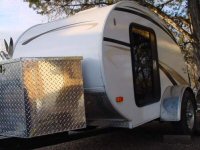6 volt car, 12 volt trailer????????
23 posts
• Page 2 of 2 • 1, 2
It is relatively easy to convert older six volt vehicles to twelve volts, You change the bulbs, battery, generator, voltage regulator, etc. and that's it. Going the other way (not that you would want to) requires completely rewiring the car. The reason for this is because for an equal wattage load, the current draw (amps) doubles when the voltage is cut in half. Thus, wiring that is engineered for a twelve volt system will be insufficient at six volts and will quickly overheat. For this reason, simply installing six volt lamps should not be tried with the (mediocre at best) wiring supplied with most trailer lighting kits.
-

Phil & Ningning - Teardrop Master
- Posts: 103
- Images: 65
- Joined: Mon Aug 21, 2006 12:38 am
- Location: Corona, CA
Whew!!!! What to do, what to do???? 


I really don't want to convert the model A to 12 volt. I do plan on putting in a 6 volt alternator.
It sure would make things easier if there was such a thing as a converter that would convert the 6 volts From the Model A to 12 volts on the trailer. That way, I could use one plug for both cars and put the converter on the trailer thus running everything via 12 volts.
I really like the idea of all LED lights on the trailer. I've been researching them and find there are all kinds of options. Trailer lights, interior lights, night lights, spot lights.........everthing a TD needs!!!
Now, how to solve my 6 volt challenge. I'm sure somebody somewhere has done this before.



I really don't want to convert the model A to 12 volt. I do plan on putting in a 6 volt alternator.
It sure would make things easier if there was such a thing as a converter that would convert the 6 volts From the Model A to 12 volts on the trailer. That way, I could use one plug for both cars and put the converter on the trailer thus running everything via 12 volts.
I really like the idea of all LED lights on the trailer. I've been researching them and find there are all kinds of options. Trailer lights, interior lights, night lights, spot lights.........everthing a TD needs!!!
Now, how to solve my 6 volt challenge. I'm sure somebody somewhere has done this before.
Bill
No matter where you go....there you are!
No matter where you go....there you are!
- Model_A Bill
- Teardrop Builder
- Posts: 35
- Images: 2
- Joined: Tue May 08, 2007 12:18 pm
- Location: Huntley, IL.




